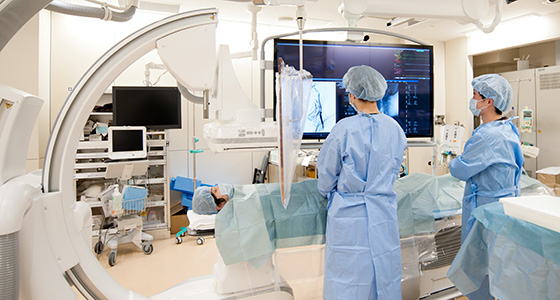- HOME
- Department
- Cerebrovascular Medicine (Stroke Medicine)
-
Related Links
Cerebrovascular Medicine (Stroke Medicine)

(1) Overview
Our department of Cerebrovascular (stroke) Medicine is mainly responsible for diagnosing, treating, and preventing strokes. Our main stay of treatments focus on treatments with administration of t-PA (tissue plasminogen activator, an Intravenous injection treatment to dissolve blood clot) in the early acute phase of ischemic stroke and the direct removal of clot blockage via intravascular catheter treatments. We collaborate closely with the neurosurgical and the rehabilitation teams in order to minimize the after effects of stroke.
(2) Policy
Striving to Treat Stroke as Early as Possible
The early treatment of ischemic stroke matters and it is often perceived as a fight against time. Early treatment with successful reopening of the blood vessels often determines the functional outcome and the prognosis for patients with strokes. We are constantly working in collaboration with the ambulance team and improving our medical system in order for our team to start the treatments for stroke as soon as possible.
(3) Our Strengths
What We Do to Minimize the After Effects of Ischemic Stroke
Ischemic stroke is one of the leading causes for patients requiring long-term care or rehabilitation. The risks of developing disability are high especially with Ischemic strokes, the most common type of stroke. However, the recent advancement in medical treatments in stroke has made it possible to reduce the burden of disability by reopening the blocked vessel at an early stage.
For instance, t-PA intravenous treatment was first introduced in Japan in 2005, followed by the commencement of intravenous catheter treatments in 2010. These treatments can potentially significantly improve the outcomes for those patients who suffered from severe ischemic stroke, which would have resulted in patients being bed-ridden in the past.
Our Team Based Approach to the Stroke Patients
The holistic team based approach to patients is extremely important when it comes to improving the outcome for patients with stroke. Our team consists of cerebrovascular medicine specialists, neurosurgeons, neurologists, rehabilitation staffs, nurses, physical therapists, occupational therapists, speech therapists and social workers. Our teams meet regularly in the morning to share information and decide on the best course of treatments for each patients.
Supporting Your Rehabilitation and Discharge
Our hospital aims to support patients in returning home after stroke and we may start rehabilitation programs from day one of the hospital admissions in some mild cases. In more severe cases however, we may refer the patients to rehabilitation hospitals for more intense rehabilitation after being discharged from our hospital.
We have established the Tokyo Jonan Stroke Network locally, and operate the common “regional critical pathway for stroke” to ensure smooth transfer of patients between the network institutions. Below are some of the rehabilitation medical institutions we work with:
| Kamata Rehabilitation Hospital | 143-0015 | 4-14-5, Omorinishi, Ota-ku | 03-5767-7100 |
| Gotanda Rehabilitation Hospital | 141-0031 | 8-20, Nishigotanda, Shinagawa-ku | 03-3779-8820 |
| Shinagawa Rehabilitation Hospital | 141-0001 | 5-2-1, Kitashinagawa, Shinagawa-ku | 03-5793-3355 |
| Harajyuku Rehabilitation Hospital | 150-0001 | 6-26-1, Jingumae, Shibuya-ku | 03-3486-8333 |
We Offer Intravascular Treatments for Stroke
The conventional methods for the treatments of ischemic stroke or cerebral aneurysm (causing subarachnoid hemorrhage) had been open surgical treatments (carotid Endarterectomy, aneurysmal clipping). However, it has recently become possible to perform minimally invasive interventional treatments such as carotid artery stenting, and cerebral aneurysm coil embolic surgeries and those new treatments have already demonstrated good safety and treatment outcomes. In addition to this, we are also performing intra /extra cranial artery angioplasty as well as head and neck embolization for some tumors.
In order to provide the best treatment for each patients, we would like to ensure that we discuss with the patients and their family in details about the options available.
Stroke Hotline – We Care For You 24/7 365 Days
NTT Medical Center Tokyo offers a Stroke Hotline available 24 hours 365 days. Doctors at our hospital usually receives calls directly from nearby medical institutions and emergency rescue teams, allowing rapid transition of care for suspected stroke patients and enabling early treatments.
Message for Our Patients
It is important to start treatments for stroke as soon as possible. We would highly recommend you to come to our hospital as soon as possible when you are experiencing symptoms of stroke. We are able to deal with the symptoms of suspected stroke in non-emergency setting and often diagnose and treat the cause of the symptoms. We are happy to consult about any neurological symptoms or cerebrovascular related matters to our department.
Prevention of stroke is important and we would always try to address risk factors for stroke such as high blood pressure, high cholesterol, diabetes, atrial fibrillation, smoking, obesity, and excessive drinking.
